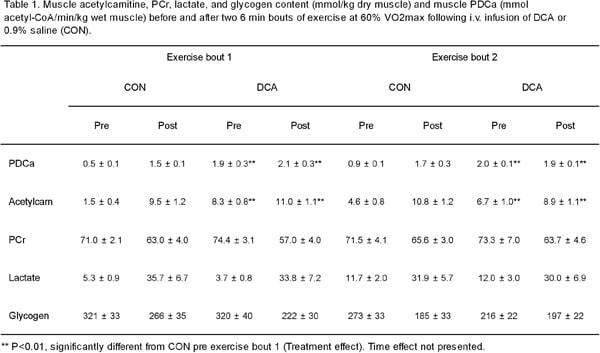Muscle phosphocreatine (PCr) hydrolysis and lactate accumulation at the onset of intense exercise is partly attributable to inertia in mitochondrial ATP production due to a lag in pyruvate dehydrogenase complex (PDC) activation and flux (the acetyl group deficit; 1). Accordingly, pharmacological activation of the PDC, using dichloroacetate (DCA), results in a stockpiling of acetyl groups in resting muscle and overcomes inertia in mitochondrial ATP production during subsequent intense exercise. During low intensity exercise however the magnitude of metabolic inertia will be less, as the rate of ATP demand will be lower, and will be better matched by the rate of PDC activation and flux at the onset of exercise. One aim of the present study was to investigate whether metabolic inertia at the level of PDC was discernable at the onset of exercise at 60% VO2max in human skeletal muscle. Secondly, to determine whether the reported effect of DCA on PDC activation persists over more than one bout of exercise. Nine healthy men (age 27 ± 2 y, body mass 77.4 ± 3.6 kg, VO2max 43.0 ± 1.9 ml/min/kg) volunteered for a study. On two randomised occasions, separated by 14 days, subjects underwent a 1 h i.v. infusion of DCA (50 mg/kg/h) or 0.9% saline (CON). Thereafter, subjects performed two 6 min bouts of cycling exercise at 60% VO2max, separated by 15 min rest. Muscle biopsies were obtained from the vastus lateralis immediately before and after each bout of exercise and analysed for glycogen, lactate, PCr, and acetylcarnitine content and muscle PDCa. Statistical analysis was performed using repeated-measures two-way ANOVA and data are expressed as means ± SEM. DCA increased resting muscle PDCa 4-fold, and was associated with a 5.5-fold increase in muscle acetylcarnitine content, compared to CON (Table 1). Following 15 min of resting recovery, PDCa had returned to basal in CON, but remained elevated in DCA. However, there was no difference in muscle lactate, PCr, or glycogen content between CON and DCA before or after either exercise bout (Table 1). In conclusion, although PDC was activated at rest, DCA had no effect on PCr hydrolysis or lactate accumulation during exercise, supporting our suggestion that the magnitude of metabolic inertia at the level of PDC is minimal at the onset of exercise at 60% VO2max. Also, the effects of DCA on PDCa can persist during recovery between two bouts of exercise.
Life Sciences 2007 (2007) Proc Life Sciences, PC76
Poster Communications: Pyruvate dehydrogenase complex activation does not limit mitochondrial ATP production in human skeletal muscle during low intensity exercise
F. B. Stephens1, D. Constantin-Teodosiu1, D. Laithwaite1, P. L. Greenhaff1
1. School of Biomedical Sciences, University of Nottingham, Nottingham, United Kingdom.
View other abstracts by:
Where applicable, experiments conform with Society ethical requirements.

